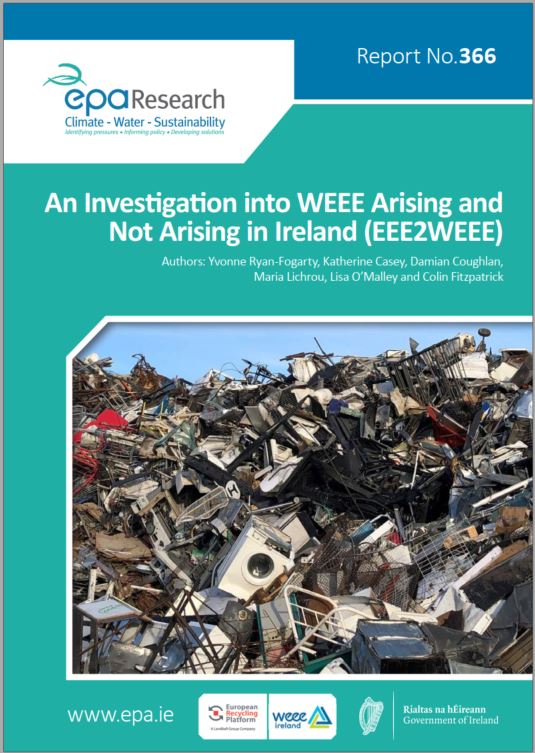Research 366: An Investigation into WEEE Arising and Not Arising in Ireland (EEE2WEEE)
Authors: Yvonne Ryan-Fogarty, Katherine Casey, Damian Coughlan, Maria Lichrou, Lisa O’Malley and Colin Fitzpatrick
Summary: Waste electrical and electronic equipment (WEEE) is the fastest growing waste stream in Europe. This research provides insight into consumer and business behaviours towards WEEE, particularly regarding how key decisions are made around WEEE disposal. This research determined a hybrid approach to WEEE target setting should be explored, using data available to Ireland and using aspects of the WEEE Calculation Tool.

Project Highlights
Watch the project highlights video
Identifying Pressures
Waste electrical and electronic equipment (WEEE) is the fastest growing waste stream in Europe. The recast WEEE Directive (2012/19/EU) laid down new collection targets of either 65% of the average weight of electrical and electronic equipment (EEE) placed on the market in the previous 3 years or 85% of WEEE arising. This represents challenges for all stakeholders in the WEEE domain. Across Europe it is recognised that collection rates through official channels remain low. This research provides insight into consumer and business behaviours towards WEEE, particularly regarding how key decisions are made around WEEE disposal. Consumer and business behaviours contribute to WEEE arising in complementary flows outside compliant WEEE collection and treatment. Scrap metal sites were surveyed and a substantiated estimate of WEEE arising was calculated. Combining consumer and business survey findings with the substantiated estimate of WEEE arising in scrap metal pointed to key intervention points by which complementary flows could be eliminated, reduced or regularised.
Informing Policy
Frugality and waste avoidance are overwhelming drivers for consumers to store EEE that is no longer in use. A lack of connection between long-term storage and pressure on virgin raw material extraction means this is likely to persist. The accumulation of items combined with finding recycling inconvenient leads to items being disposed of at “critical moments” with a high “push factor” for materials to enter complementary streams.
WEEE accounts for a tiny proportion of waste in organisations and therefore does not command much attention. Trust is placed in waste contractors to dispose of information and communications technology (ICT) WEEE appropriately, but other items of WEEE are not considered.
In total, 415 tonnes of scrap iron, steel and mixed metals from construction and demolition and municipal waste were sampled. An estimated 3.91% ± 1.88% of the sample contained WEEE, equating to 10,950 tonnes or 2.28 kg/capita (± 1.1 kg/capita) based on 2018 data. Home renovations are critical moments in the disposal of WEEE. Professional WEEE accounted for almost 30% of WEEE observed in metal scrap.
The WEEE Calculation Tool’s functionality depends on high quality data. Its importance may lie as a cross-reference tool for identification of free riders as well as new emergent technologies and their likely impact on target achievement.
Developing Solutions
The convenience and visibility of WEEE recycling needs to be increased. Consumers are positively disposed towards recycling of WEEE, but it needs to be normalised and made easier. Small WEEE collections could be included in the delivery of large EEE and additional visible collection opportunities should be provided in frequently visited locations.
More repair, “preparation for reuse” and reuse opportunities for consumers would assist consumers and businesses to make connections to appropriate treatment rather than waste avoidance through storage, which is current practice. This would provide channels for WEEE to enter the formal accounting systems.
Another key recommendation is to explore incentives and penalties to facilitate mandatory handover and the direction of WEEE to appropriate recycling systems from skip hire companies, waste collectors and scrap metal facilities. This would aid in removing WEEE from complementary flows when consumers and organisations act inappropriately at “critical moments”.
Further work is necessary to support greater collection rates of business to business WEEE, in particular from small to medium-sized enterprises, for which appropriate disposition of WEEE, with the exception of data-bearing devices, is often not a priority. The further work should target greater awareness of the appropriate means of disposal and should also focus on waste collectors.
Finally, a hybrid approach to WEEE target setting should be explored, using data available to Ireland and using aspects of the WEEE Calculation Tool.
https://www.epa.ie/media/epa-2020/research/epa-funded-research/Twitter_366.jpg